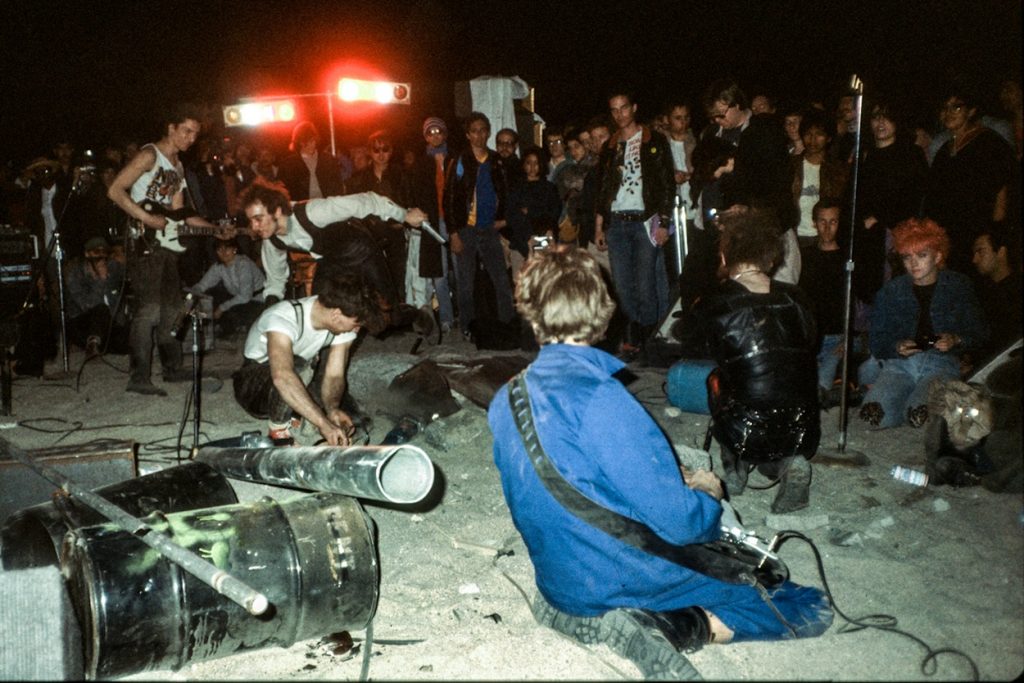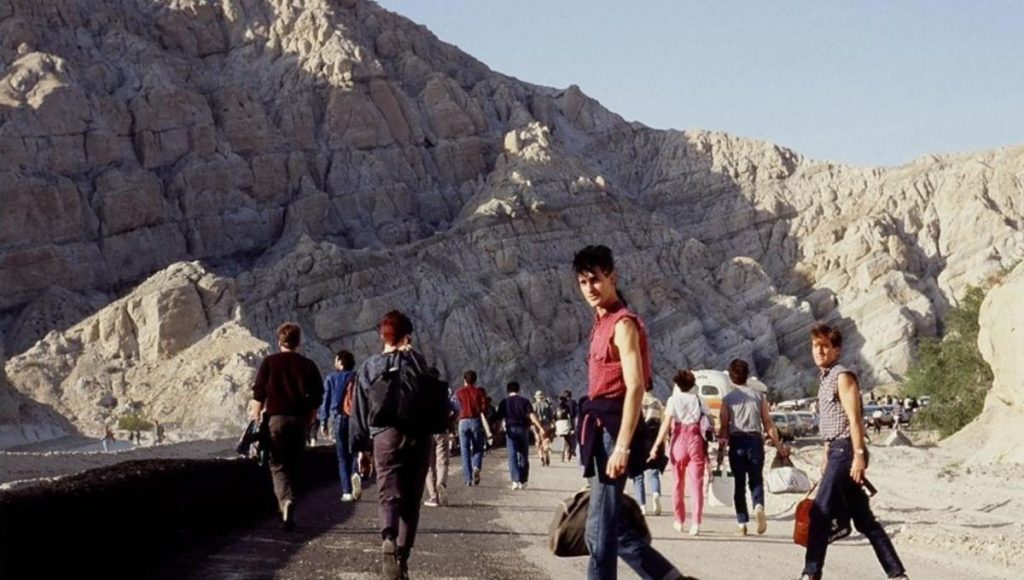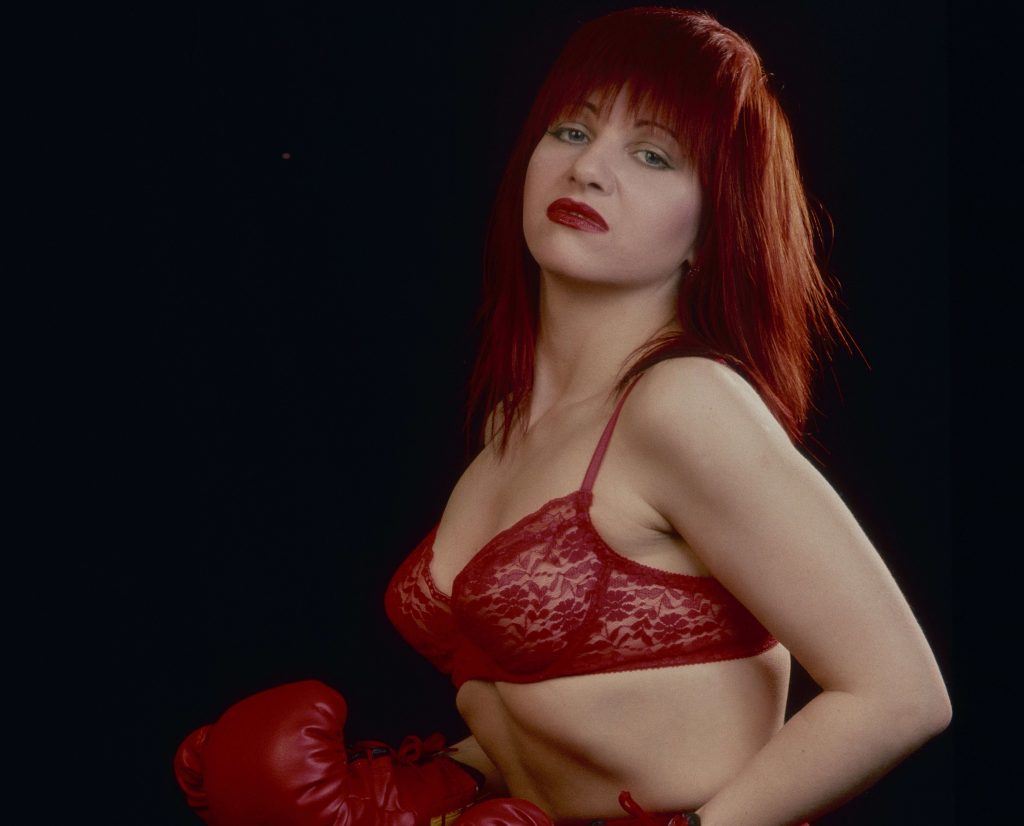June 30, 2020
by Carla Hay

Directed by Stuart Swezey
Culture Representation: Taking place in various locations in Southern California, the music documentary “Desolation Center” interviews a racially diverse group of people (white, African American, Latino and Asian) talking about the notable 1980s rock concerts promoted by the independent team Desolation Center, with commentaries from artists, fans and behind-the-scenes industry people.
Culture Clash: Desolation Center concerts, which rejected anything that was corporate, often operated outside the law by not filing permits and by being held in unconventional places.
Culture Audience: “Desolation Center” will appeal primarily to people interested in the non-mainstream Los Angeles rock scene in the 1980s and stories about music festivals.

Imagine a well-attended music festival that takes place in the California desert. Event permits weren’t filed, people were transported by school bus to the festival, and most attendees were so excited about going that they didn’t think about bringing sunscreen, water or food. And there wouldn’t be any vendors at the festival to sell anything. This festival obviously isn’t Coachella.
The documentary film “Desolation Center” is a nostalgic and fascinating look at five of the biggest concerts staged by a Los Angeles-based independent promotion team called Desolation Center. In its relatively short existence (1983 to 1986), Desolation Center influenced several festivals that ended up becoming corporate behemoths, including Burning Man, Lollapalooza and Coachella. The five Desolation Center concerts that get the spotlight in the documentary are Mohave Exodus, Mohave Auzug, Joy at Sea, Gila Monster Jamboree and Solstice.
“Desolation Center” director Stuart Swezey, who also appears on camera for his commentary, is the best person to helm this documentary, since he founded Desolation Center and had hands-on involvement in every show presented by the team. His deep history with Desolation Center serves this film well, since it’s packed with a lot of great archival photos and video footage, as well as an extremely well-rounded set of interviews from artists, fans and behind-the-scenes industry people who usually have first-hand accounts of Desolation Center shows.
Artists interviewed include the members of Sonic Youth (except for Kim Gordon), Meat Puppets, Minutemen, Redd Kross and Einstürzende Neubauten. Also giving an artist perspective are Perry Farrell (co-founder of Lollapalooza Festival and the band Jane’s Addiction); Aaron Sherer (who was in Psi Com, Farrell’s pre-Jane’s Addicition band); Kurt Schellenbach of Nip Drivers; Suzi Gardner of L7; Michael Gra of Swans; Dan Bolles of the Germs; Chuck Dukowski of Black Flag; Steve Housden of Lawndale; Ian Rakow of Valley Punk; F.M. Einheit; artist Anthony Ausgang; noise musician Boyd Rice; performance artist Ron Athey; poet John Tottenham; and performance artists Mark Pauline and Matt Heckert of Survival Research Laboratories.
Unlike many music documentaries that shun or limit perspectives of non-famous fans, “Desolation Center” gives almost as much screen time to fans as it does the artists. Among the fans who share their fond memories of Desolation Center shows are poet Maw Shein Win; musician Sean DeLear; community organizer Linda Kite; costumer designer Nancy Steiner; Sandy Glaze; Lisa Derrick; Janet Housden; Easter Seals COO Bev Mendes; artist Kristine Kryttre; Bertell Ferguson; Skip King; ML Compton; Mike Guerena; Fourway Cross bandmates Courtney Davies, Steve Gerdes and Tom Dolan; and married couple Joy and Ken Abbott, who’ve been together since the ’80s.
Also giving their insight are Goldenvoice founder Gary Tovar; Burning Man co-founder John Law; indie music operative Carmel Conlin; SST producer Spot; photographer/musician Mariska Leyssius; sound engineer Ed Cirino of Gold Sound; Re/Search Publications editor/publisher V. Vale, music publisher Adam Wolf; and journalists Chris Morris, Simon Reynolds, Joseph Bien-Khan.
“Desolation Center” begins with a contextual backdrop of what was going on in the Los Angeles music scene during the 1980s that laid the groundwork to form Desolation Center. If there’s any villain of this story, it’s Daryl Gates, who was chief of the Los Angeles Police Department (LAPD) from 1978 to 1992. DeLear calls Gates “rotten” and “creepy” in the documentary.
And several people who comment in the film, including Swezey, describe the LAPD under Gates’ leadership as an oppressive force that targeted punk rock musicians and fans for harassment and arrests. Bolles says, “The LAPD freaked out about punk rock, like it was the second coming of the Black Panthers.”
Therefore, nightclubs and bars in Los Angeles that booked punk artists frequently had those shows shut down or heavily enforced by the LAPD. Meat Puppets lead singer/guitarist Curt Kirkwood adds, “It seems like they [the LAPD] were going through the newspaper and finding bands that sounded punk rock and making sure they didn’t happen.” Performance artist Athey comments on Los Angeles: “I grew up here. I wasn’t enlightened that you could live in a non-police state, so you figured out how to skirt around it.”
The good news is that in the early 1980s, the alternative/underground music scene was very diverse, in terms of race, gender, sexuality and economic backgrounds. Kite, who was the fiancée of Minutemen singer/guitarist D. Boone, comments on the Los Angeles punk/underground music scene during this era: “There was just as much people of color in it as there were white kids. Bands were multicultural, as well as the scene was multicultural.”
This diversity was in stark contrast to Los Angeles’ heavy metal scene and classic rock scene, which pretty much excluded musicians who weren’t straight white males. Another big difference between the punk scene and communities for other rock genres was that punk was all about rejecting conformity and corporate greed.
Swezey comments in the documentary: “In the early ’80s, I think the rest of the world saw L.A. as this brain-dead, sun baked, smoggy sprawl—which it kind of was. For those of us who grew up here, the early ’80s was actually a really vital and interesting time.”
Before Swezey founded Desolation Center, he was a 21-year-old college dropout doing phone sales for a municipal broker in 1982. Although he was a fan of punk music and went to a lot of shows, he wasn’t inspired to become a show promoter until he saw a Throbbing Gristle concert and later met its promoter Michael Sheppard. Swezey says of that fateful Throbbing Gristle show: “Their sonic assault changed the way I thought of music and performance forever.”
He took the plunge to form Desolation Center in 1983, as an independent collective to promote “alternative” rock and performance artists. At the time, Swezey was living in a very seedy and run-down part of downtown Los Angeles. He says he came up with the name Desolation Center “because that’s how I was feeling about my environment at the time.”
Desolation Center was born out of nonconformity, not just because of punk ideals but also out of financial necessity. The tiny start-up didn’t have the budget to book artists at established nightclubs and advertise those types of shows. Therefore, Swezey and Desolation Center had the great idea to do the opposite of what most concert promoters were doing.
Desolation Center booked shows in abandoned warehouses and other under-the-radar places. The shows also didn’t follow industry norms: Guests lists weren’t allowed, everyone had to pay to get inside, and the shows didn’t sell alcohol (which would get the attention of the police), but people of legal drinking age were allowed to bring their own alcohol. Desolation Center also didn’t advertise its shows and did not court publicity.
Having these shows in non-traditional venues also allowed Desolation Center to not have to deal with Ticketmaster or city permits to put on these shows. And finding about these shows, not through advertising or media publicity, but through word of mouth, gave Desolation Center a cool, underground reputation with fans. Nowadays, with insurance liabilities being more of a concern for artists and promoters, an outfit like Desolation Center wouldn’t have been able to stay in business for as long as it did.
It wasn’t long before Desolation Center wanted to do something bigger than just a small show in a warehouse, without having to go to a traditional large venue. After taking a road trip through the Sonora Desert in Mexico, Swezey was inspired to have the first Desolation Center festival in the desert. He approached Savage Republic band member Bruce Licher, who came up with the idea to have the show in the Mohave Desert, about three hours east outside of Los Angeles.
That show ended up being a mini-festival called Mohave Exodus, which took place on April 24, 1983, and featured performances by Savage Republic and Minutemen. Licher had access to a printing press, so he was essentially in charge of making the tickets and signage that were used for the show. Farrell says of Licher: “He was like the Benjamin Franklin of our scene.”
Getting to the concert site was unconventional. There was a secret place in downtown L.A. where ticketholders were told to meet. From there, rented school buses took them to the remote area in the desert. Many of the fans were completely unaware of how hot the desert heat would be and were decked out in full-on heavy punk gear.
Kryttre, an artist who attended the event, remembers how driving to the concert site was a challenge because some of truck stop managers would lock their restrooms when they saw all the “alternative”-looking young people coming out of the buses to use the restrooms. The way these fans looked back then wouldn’t be considered a big deal today, but it was a big deal back then.
The concert was so bare-bones and do-it-yourself that nothing was set up in the middle of the desert except for the band’s equipment and sound system. There was no stage separating the band from the audience. Most concertgoers had to sit on the hard desert ground, although some people thought of bringing lawn chairs. And forget about places to eat, drink and use toilets at the concert site. There weren’t any.
And they weren’t prepared for the forceful desert winds in the area. Sound engineer Cirino remembers that socks had to be put on microphones, and the buses had to be parked behind the bands to form a wall that would be a wind barrier. It was about as unglamorous and uncomfortable as you can imagine. But looking back on it, the concertgoers and band members interviewed in the documentary say they loved the experience.
Win comments, “I felt we were these young people creating this great, alternative world for ourselves out in the desert.” Guerena says, “There was no violence, no weirdness. It was like everybody was in this one cool group.” Joy Abbott adds, “I just remember thinking, ‘This is one of the coolest things I’ll ever do in my whole life.'”
After the Mohave Exodus show, Swezey quit his day job and went backpacking around Europe. While he was in West Berlin, he saw German industrial band Einstürzende Neubauten perform for the first time and was completely awed by the experience. It was around this time that Swezey saw director Werner Herzog’s epic 1982 movie “Fitzcarraldo,” which also gave Swezey the idea for the next big Desolation Center festival.
In “Fitzcarraldo,” a European opera fan becomes obsessed with building an opera house in the Peruvian jungle. Swezey explains how Einstürzende Neubauten and “Fiztcarraldo” inspired him: Instead of bringing opera to the jungle, he wanted to bring industrial music to the desert.
And that led to the Desolation Center show Mohave Auzug, held in Mecca, California, on March 4, 1984. Einstürzende Neubauten headlined the show, which was more elaborate—and crazier and more dangerous—than Mohave Exodus. A pacifist percussion group Djemaa-El-Fna greeted concertgoers as they arrived.
But that peaceful atmosphere was quickly destroyed by Survival Research Laboratories, a rebellious group of performance artists (whose most famous member is Mark Pauline), who loved to literally blow things up. And the desert was their playground at the show, as they set off explosives in a cave, as well as other places outside, despite the objections of Djemaa-El-Fna and some concertgoers.
Luckily, no one was hurt at Mohave Auzug by these explosions. Pauline and the rest of the anarchists look back with no regrets and say the explosions were all in the name of fun and performance art. Lawndale band member Housden remembers that at this industrial-oriented concert, power tools were used as musical instruments and other playthings: “They were giving a hard time to our dad’s power tools … They ruined them.”
With two well-received desert concerts under his belt, Swezey decided that the next big Desolation Center concert would be at an opposite location: on the water. The Joy at Sea concert was held in the San Pedro Harbor in California, on June 15, 1984. The headliners were San Pedro hometown band Minutemen and Arizona-based band Meat Puppets. Meat Puppets bass player Cris Kirkwood says of the experience: “It was one of the highlights of my musical career in a lot of ways—just magical as crap.”
Then, it was back to the California desert. Gila Monster Jamboree was Desolation Center’s biggest event yet, and is probably considered the most important one for Desolation Center. Taking place on January 5, 1985, the bill included Sonic Youth (in the New York City band’s West Coast debut), Meat Puppets, Redd Kross and Psi Com, which was Farrell’s band before he formed Jane’s Addiction.
In the documentary, Farrell admits that Psi Com got the gig because he was Swezey’s roommate at the time. “It was really cool, so I thank you for that,” Farrell says. Meat Puppets frontman Curt Kirkwood remembers that everybody at the concert seemed to be in a good mood because most people were flying high on LSD. Montgomery, one of the fans at the concert, says: “There were very few people who weren’t tripping.”
Unlike previous Desolation Center concerts in the desert, where the concertgoers could only get there by Desolation Center’s provided buses, Gila Monster Jamboree gave concertgoers the option to take their own transportation to the concert site, although bus transportation was still provided for those who wanted it. There were was still none of the commercial trappings (merchandise booths and food vendors), sanitary facilities, or safety precautions that are presumed for today’s music festivals. Because, just like other Desolation Center concerts, the promoters didn’t have a permit to hold the event.
Steve and Jeff McDonald, the brothers who co-founded Redd Kross, remember the nerve-racking experience of having a driver who got lost for hours, making the band very late for the concert. Redd Kross was the first “glam rock” band to perform at a Desolation Center festival. And ironically, the band was so late, the members of Redd Kross didn’t have time to change into their glammed-up stage clothes and instead performed in jeans and sweatpants, which was outside their comfort zone for their stage wardrobe.
Desolation Center’s permit-avoiding ways eventually caught up to the team, which was fined $400 for the Gila Monster Jamboree show. Swezey says that $400 was a lot of money to them at the time. So, in true D.I.Y. fashion, Desolation Center held a Trespass Benefit show to raise funds to pay off the fine. Minutemen and Nip Drivers performed at the fundraising concert, which was held at the Anti Club on Augusts 4, 1985.
Desolation Center’s last big hurrah was the Solstice concert on December 21, 1985. Sonic Youth and Swans topped the bill for the show, which had the unusual distinction of being partially funded by the National Endowment of the Arts (NEA). Swezey says that a friend who received NEA grant money approached him to do the show.
But tragedy struck on December 22, 1985, when Minutemen lead singer D. Boone was killed in a car accident that injured his fiancée Kite and permanently disabled Kite’s sister. It was an end of an era. Swezey says in the documentary that Boone’s death and the stricter laws being enforced for concert promotion led to the decision to say goodbye to Desolation Center and move on to other things. Swezey then founded Amok Books, an alternative publishing company.
“Desolation Center” isn’t just for people who remember what it was like to be a fan of alternative music in the early ’80s. It’s the type of documentary that people of many generations can enjoy if they like the bands in the film and if they want to get a meaningful historical time capsule of a specific subculture of the Los Angeles music scene in the early-to-mid-1980s.
It might also make people wistful for a bygone era when people went to concerts and festivals and lived in the moment, instead of worrying about how things were going to look on social media. Remarkably, no one was killed or maimed at a Desolation Center concert, which is in stark contrast to all the concerts that have happened since the ’80s that have experienced mass shootings, bombings and other weapons of war against innocent concertgoers.
Desolation Center wasn’t exactly about “peace and love” all the time, but one of its greatest legacies that’s been largely abandoned by most big concert promoters is that the shows embraced people from all sorts of backgrounds, by not excluding people through ticket prices that are too high for certain people’s budgets. Those days might be long gone for music festivals, but this documentary is a significant reminder of how it was possible back in the ’80s and how well it worked.
Passion River Films released “Desolation Center” on digital, VOD and DVD on June 23, 2020.

